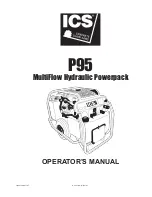
16 | SAMLEX AMERICA INC.
SeCtIOn 7 |
limiting electro-Magnetic
Interference (eMI)
Then, if necessary, relocate either the antenna or the power supply farther apart. The
receiver may “hear” the power supply. A slowly moving, slightly buzzing carrier heard
in the receiver may be caused by the antenna being too close. As with the transmitter
related noise pick up, a loose coaxial connector or a broken or a missing ground may
aggravate this problem. Normally, this noise will be below the background or “band”
noise. Increase the separation between the power supply and the receiving antenna.
Use an outdoor antenna. This will reduce the amount of signal picked up from the
power supply and also increase the amount of the desired signal.
ADDitionAL GUiDeLineS FoR ReDUcinG RF noiSe
• Use additional appropriate AC Radio Frequency Interference (RFI) Power Line Filter
rated for minimum 10A immediately before the AC input of the power supply. for
example, consider suitability of Model # 6VN1 from Tyco Electronics www.te.com
or similar. filtered, ferrite Coated Cord Set is another choice. These cord sets, with
integral line interference filters, reduce Common and Differential Mode Interfer-
ences over a wide frequency range. Because they are shielded, they are also effec-
tive against radiated interferences. In addition to the built-in filter networks, the
cable conductors are coated with an rf absorbing ferrite compound. This provides
additional attenuation at high frequencies that is lacking in most regular LC filters.
The rf absorption of the ferrite-coated cable avoids resonances at high frequencies,
reducing the conducted and radiated rf noises even further. for example, consider
suitability of EMC Cord “IMU-13” from EMC Eupen www.emceupen.com or similar.
• Use additional appropriate DC radio frequency interference (RFI) power line filter
rated for minimum 30 A immediately after the DC output of the power supply. for
example, consider suitability of 30A filter Model # “fD10EE030” from Curtis Indus-
tries www.curtisind.com or similar.
• Twist the Positive and Negative wires from the output of the power supply to the radio.
• The DC side Positive and Negative outputs of these power supplies are isolated from
the chassis. As explained earlier, the noise currents are filtered to the chassis of the
unit and the chassis is connected to the Earth Ground through the Earth Ground Pin
of the AC power outlet receptacle. Avoid connecting (referencing) the DC Negative
output terminal of the power supply to the Earth Ground.
• Connect a ¼” wavelength of wire on the Negative terminal of the power supply.
Connect one end of the wire to the Negative terminal and leave the other end free.
The wavelength corresponds to the wavelength of the interfering frequency. (May
not be practical for long wave lengths).
[Formula: Wave length (Meters) = 300 / frequency in MHz]









































